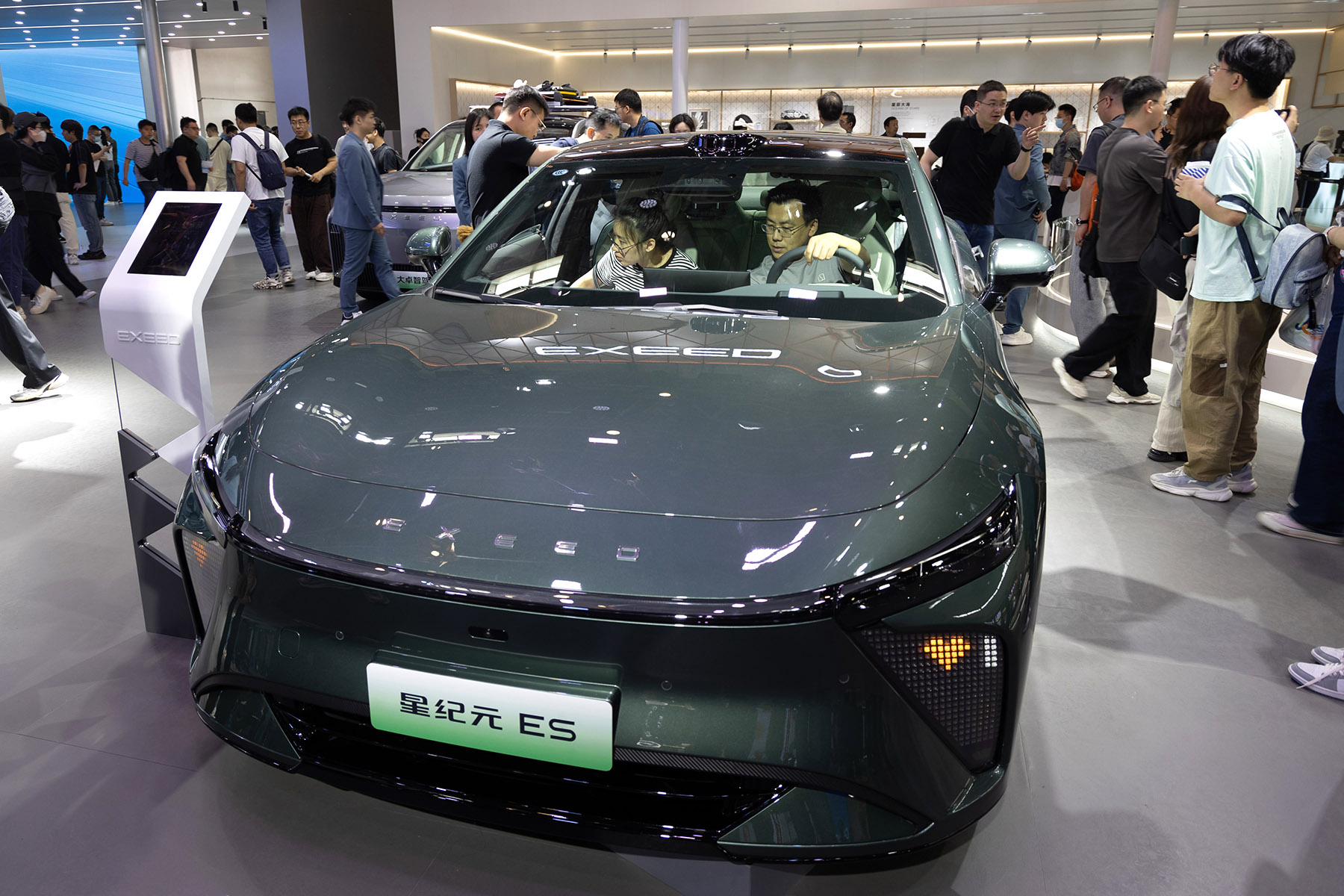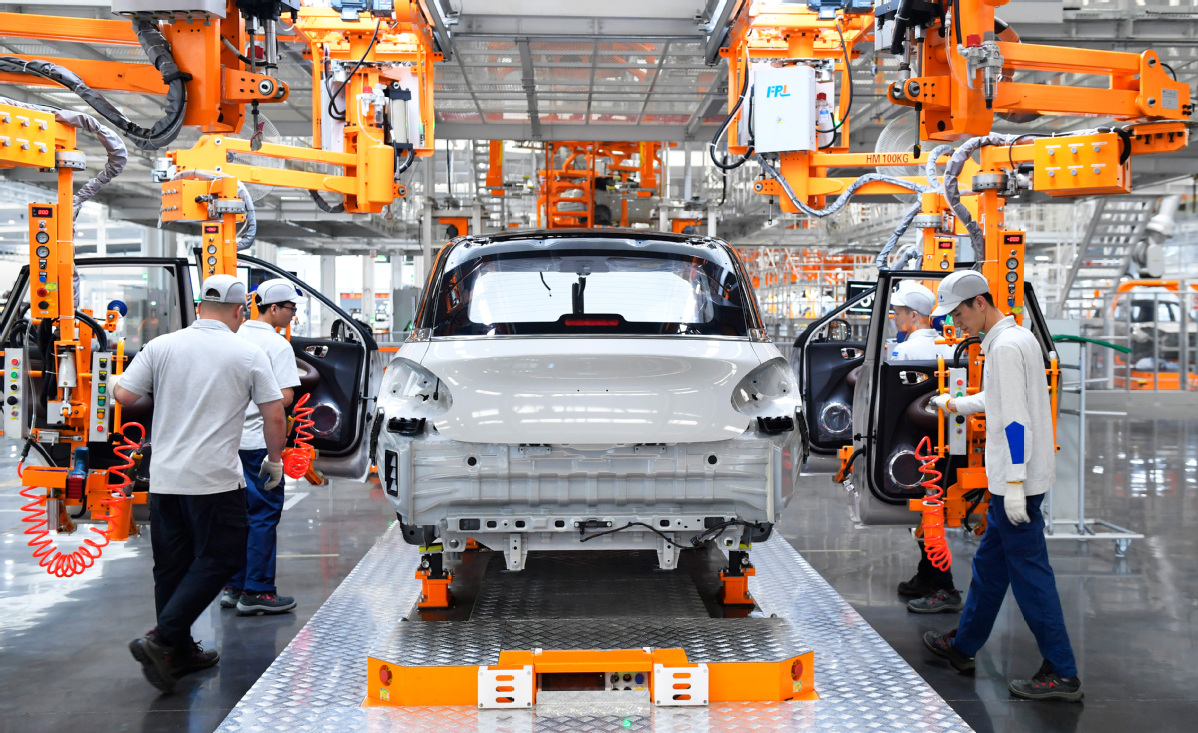State enterprises leverage strengths in R&D, sales and service platforms, take their firms to a higher level

At the Shanghai Haitong International Automotive Terminal in Waigaoqiao area, nearly 2,000 electric vehicles were driven onto a car carrier in late May.
These vehicles, produced by State-owned carmakers SAIC Motor and Chang’an Automobile Co, are scheduled for delivery to dealers and consumers in South America this month.
With China’s EV industry developing advantages of scale after more than a decade of growth, State-owned automakers, such as China FAW Group, Dongfeng Motor Corp, Guangzhou Automobile Group and Beijing Automotive Group, are reinforcing their positions in the fuel-powered vehicle market while aggressively expanding into the EV sector.
To stay competitive, they are capitalizing on their strengths in research and development, sales networks and services to continuously forge new paths for growth.
Zhu Huarong, board chairman of Chongqing-based Chang’an Automobile, said the global automotive market will enter a new era dominated by EVs, pushing Chinese brands to go global.
Chang’an Automobile plans to launch around 60 products by 2030, entering more countries, building overseas sales networks in 20 global locations and investing 4 billion yuan ($552 million) in Thailand to build a global production base.
“Cars, initially just modes of transport, will transform into digital platforms, resembling connected and intelligent automotive robots,” Zhu added.
While Guangzhou Automobile Group exports its products to more than 27 countries across the Middle East, the Americas, Africa and Southeast Asia, Beijing Automotive Group and SAIC Motor are collaborating with foreign partners or setting up factories and innovation centers overseas to broaden their global footprint.
Headquartered in Wuhan, Hubei province, Dongfeng Motor is also focusing on optimizing its business roadmap and has set a target of 3.2 million units in total sales and 300,000 units for exports this year.
The company plans to launch 14 new models of self-branded passenger EVs and 10 commercial EVs from 2024 to 2025, as it continues to integrate research and development resources with investments exceeding 50 billion yuan over the next three years.
Automakers in China exported 1.83 million units of fuel and electric powered vehicles in the first four months of this year, up 33.4 percent from the same period of 2023, data from the China Association of Automobile Manufacturers show.
China’s surging EV export volume has provided strong support for the growth in sales of domestic brands.
Chinese automakers launched 94 new models of new energy vehicles in 2023. This is 13 times the number introduced by joint venture brands in the same year, with domestic NEVs accounting for 80.6 percent.
Chen Shihua, deputy secretary-general of Beijing-based CAAM, said the market share of domestic passenger cars has consistently risen, powered by the swift expansion of the EV sector and a significant surge in car exports.
Moreover, domestic brands are undergoing rapid transformation, with leading domestic automakers moving toward electrification and smart technologies at a notably faster pace than foreign groups and their joint ventures, he said.

Echoing that sentiment, Yu De, managing director of SAIC Motor’s international business unit, said that in addition to ordinary household users in many parts of the world, Chinese EVs are also favored by a large number of ride-hailing drivers in foreign countries, who generally perceive these vehicles as being of high quality and offering more value for money.
As China embraces a new era of growth driven by sustainability and innovation, State-owned enterprises from other industries have deployed more resources and manpower in strategic emerging industries, including artificial intelligence, high-end manufacturing, new energy, new materials, “new infrastructure” and biotechnology to pursue transformative changes.
SOEs, including train manufacturer CRRC Corp, energy giant China National Offshore Oil Corp (CNOOC) and telecommunications operator China Telecom Corp, are quickening efforts to develop new growth engines in the areas of strategic emerging industries.
For example, CRRC has developed 46 support policies to speed up the strategic layout of new industries, completed 118 new industrial research projects, and joined 11 innovation consortia established by multiple centrally administrated SOEs.
With China creating more favorable conditions to nurture new quality productive forces, Sun Yongcai, board chairman of Beijing-headquartered CRRC, said that high-end manufactured products are crucial to the national economy and strategic security, serving as a key support for industrial upgrading and technological advancement.
New quality productive forces are productivity advances freed from traditional economic growth modes and development paths, featuring high-tech, high efficiency and high quality, and in line with the new development philosophy.
China’s first high-power hydrogen energy-powered shunting locomotive, jointly developed by CRRC Zhuzhou Locomotive Co and CHN Energy Investment Group, completed a 10,000-metric ton loading test for the first time at the Sidaoliu station of the Xinshuo Railway in the Inner Mongolia autonomous region, in late April.
The train used hydrogen as energy for towing 105 rail vehicles for 2 kilometers at a constant speed. This marks a key breakthrough in the market-oriented application of high-power hydrogen energy power equipment for China’s heavy-haul railways, CRRC said in a statement.
Meanwhile at CNOOC, apart from extracting crude oil and natural gas, detailed plans have been formulated by the firm to advance the development of strategic new industries such as high-end manufacturing of marine oil and gas equipment, new energy and new materials in the coming years.
Pan Helin, a researcher specializing in digital economy at Zhejiang University’s International Business School in Haining, Zhejiang province, said the growth of SOEs in the field of AI can enhance national competitiveness, and sharpen technological discourse and initiative. Their abundant resources can inject vitality into the industry.
“At the same time, with the development of AI technology, SOEs can also achieve transformation and upgrading, as well as reinforce their earnings strength,” said Pan.
Eager to maintain a key role for China in the global AI industry, the State-owned Assets Supervision and Administration Commission of the State Council earlier this year urged central SOEs to enhance demand-driven strategies, expedite support for key industries, establish high-quality multimodal data sets and foster a comprehensive industrial ecosystem. This approach would encompass infrastructure, algorithm tools, intelligent platforms and solutions.
Central SOEs have already accelerated their footprint in the field of AI.
For instance, China United Network Communications Group Co, a telecommunications operator, established an AI innovation center in Beijing in January. The group views AI as a crucial strategic direction and is hastening its efforts to develop AI technologies.
The combined profits of SOEs grew by 2.8 percent year-on-year to 1.08 trillion yuan in the first quarter of this year, data from the Ministry of Finance showed.
These SOEs generated 19.81 trillion yuan in operating revenue during the three-month period, up 3.2 percent from a year earlier, according to the data.


